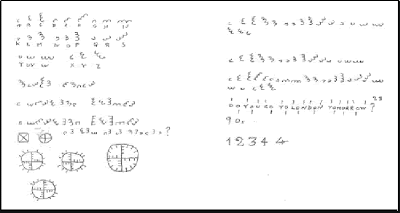Below, in Figure 1, you can see the famous Dorabella Cipher, which Edward Elgar wrote to Miss Dora Penny 1897.
 |
| Figure 1. The Dorabella Cipher (1897) |
What makes this cipher so special is, that it was sent by Elgar (who liked to play around with ciphers and word puzzles) to a Lady who had no particular background or interest in ciphers. They only met a few times and yet Elgar was sure that she could somehow decipher his message.
Over the years, several solutions to the cipher have been proposed, but none has been accepted as correct by the community. It is thought to be a simple monoalphabetic substitution cipher and was not solved because of the short ciphertext, which neglects attacks based on letter frequencies.
So far, there is only one solution which seems somehow promising to me (Tim S. Roberts, Solution). It is because of the very meaningful recovered plaintext, but it still contains some really strange inconsistencies and doubtful steps. There are many websites that discussed his solution and i will not restate any of them here.
The symbols used in the Dorabella Cipher reminds one of a Pigpen Cipher. And this theory could be supported with some further hints:
The E-like symbols from the Dorabella Cipher also appear in some of Elgar's notebooks, see for example Figure 2. You can see, that Elgar is playing around in order to find a suitable letter-to-symbol configuration. On the bottom left you can see circles with a cross in them and those little marks at eight distinct positions.
 |
| Figure 2. Notes from Elgar (from 1920?) where he plays around with the same symbols. |
- "MARCO ELGAR" (the name of his dog)
- "A VERY OLD CYPHER"
- "DO YOU GO TO LONDON"
Elgar used three different types of cipher symbols and each one could be oriented in eight different directions, thus in total 24 possible symbols. As usual, see also Figure 2, the letters I and J as well as U and V are combined to reduce the alphabet from 26 to 24 characters.
 |
| Figure 3. A Pigpen circle and a possible symbol mapping. |
But even if he used this circles as the base for his Pigpen Cipher, in what order did he assign the letters to the circles segments? And did he used the same Pigpen circle for all 24 symbols or do they differ for the three different symbol types? Or did he somehow encoded all 24 symbols in one such circle? The last question is backed-up by the fact, that there are exactly 24 little lines on that circle. So each such line could represent a symbol rather than three of them.
This approach was also taken by Tony Gaffney and produced the, so called, Hellcat Solution.
 |
| Figure 4. Tony Gaffney's Pigpen circle for his solution. |
"B Hellcat ie a war using effin henshells! Why your antiquarian net
diminuendo? Am sorry you theo o’ tis god then me so la deo da — aye"
I can not believe that this is the correct message, although i like the approach using this particular Pigpen circle. Surprisingly, in 1885, already a decade before writing the Dorabella cipher, Elgar used these symbols to make an annotation against a couple of lines of music.
 |
| Figure 5. Elgar's annotation from 1885. |
 |
| Figure 6. Rotated annotation text. Known as the "Liszt Fragment". |
"Mes it's one Frn seezhup"
Other annotations or pieces of text along the music lines in his notebook are said to be something like "Very good performance", "slightly out of tune", "poor", "beautiful", "I think you know this a little", "very well done august" and so on. Why should he wrote the itself rather cryptic sentence "Mes it's one Frn seezhup"? And why would he encrypt an musical annotation at all while leaving many others in plaintext?

.... Actually looking at that sheet than looking at the letter its pretty clear at a single glance he has outlined those notes to which correspond to his anots and than later wrote her a song using the anots as a shortened version of the full music sheet.
ReplyDeleteThe Dorabella Cipher Solution
ReplyDeleteCiphertext (transcribed):
AIBJQCUJTDKEWXENEECIIEXSDSVKL
UEUCUJTHJBEEBCVWUEKECFLWXSTTSKL
BLCFLBXFMVLBECFWLXJIVLCJXSJ
Key:
PSTYEHKWBARIGMXJFVOLDUNCZQ
Plaintext:
PBS AFT DALYRENCE MEET B BECO YOUR IDEDTD ALWASE
E STUNDER E THINC OLL OR IS IT HIS CH GUISE
THNIC ABU IT ACOA
Message:
Problems after dalliance meet is because your identity always
a stutter I think all or is it his charming guise?
Think about it acolyte.
It's time to stop using the same methods that don't produce a clear message or offering random decryptions with no explanation as to how they arrive at their cleartext. Please visit https://jamesmulliss.wordpress.com/a-new-approach/ for a solution that doesn't muck around in well worn tracks.
ReplyDelete